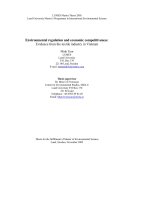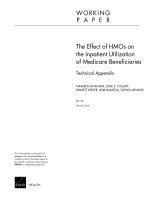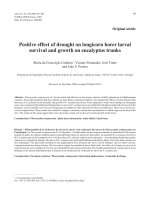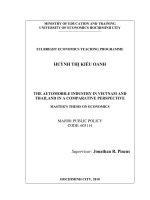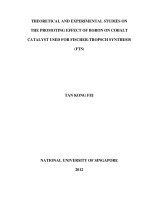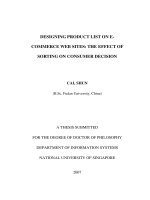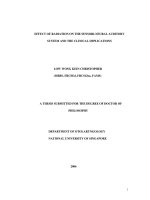The moderating effect of locus of control on job stress job satisfaction relationship evidence from the banking industry in vietnam
Bạn đang xem bản rút gọn của tài liệu. Xem và tải ngay bản đầy đủ của tài liệu tại đây (956.63 KB, 58 trang )
UNIVERSITY OF ECONOMICS HO CHI MINH CITY
International School of Business
------------------------------
Hong Phuong Nhi
THE MODERATING EFFECT OF LOCUS OF
CONTROL ON JOB STRESS-JOB SATISFACTION
RELATIONSHIP: EVIDENCE FROM THE
BANKING INDUSTRY IN VIETNAM
MASTER OF BUSINESS (Honours)
Ho Chi Minh City - Year 2016
UNIVERSITY OF ECONOMICS HO CHI MINH CITY
International School of Business
------------------------------
Hong Phuong Nhi
THE MODERATING EFFECT OF LOCUS OF
CONTROL ON JOB STRESS-JOB SATISFACTION
RELATIONSHIP: EVIDENCE FROM THE
BANKING INDUSTRY IN VIETNAM
ID: 22140033
MASTER OF BUSINESS (Honours)
SUPERVISOR: Dr. Tran Phuong Thao
Ho Chi Minh City - Year 2016
Table of content
1. Introduction ..................................................................................................................... 6
2. Literature review and hypothesis development .............................................................. 9
2.1. Foundational theory .................................................................................................. 9
2.2. Related review and hypothesis ............................................................................... 10
3. Research method ........................................................................................................... 20
3.1. Procedure and sample ............................................................................................. 20
3.2. Measurements ......................................................................................................... 22
4. Data analysis and results ............................................................................................... 23
4.1. Measurement validation ......................................................................................... 23
4.2. LOC as moderator of job stress - job satisfaction relationship: ............................. 25
4.3. Common method variance ...................................................................................... 26
4.4. Hypothesis testing ................................................................................................... 27
4.5. Discussion ............................................................................................................... 32
5. Conclusions ................................................................................................................... 34
5.1. Implications for theory and research ...................................................................... 34
5.2. Implications for managers ...................................................................................... 35
5.3. Conclusions............................................................................................................. 35
5.4. Limitations and directions for future research ........................................................ 36
Appendix 1. Scale items ................................................................................................. 38
Appendix 2. Questionnaire English version ................................................................... 40
Appendix 3. Questionnaire Vietnamese version (Bảng câu hỏi khảo sát) ..................... 43
References ......................................................................................................................... 48
List of tables and figures
Table 1 : Literature review .............................................................................................. 17
Figure 1 : Conceptual model............................................................................................. 20
Table 2 : Descriptive statistics......................................................................................... 22
Table 3 : Means, Cronbach alpha, and EFA loadings of items after deleting items ....... 24
Table 4 : Means, standard deviations, correlations and internal consistency
reliabilities .......................................................................................................... 28
Table 5 : Results of hierarchical regression testing moderating hypotheses for
whole sample ...................................................................................................... 30
Table 6 : Results of hierarchical regression testing moderating hypotheses for
two groups .......................................................................................................... 31
Table 7 : Results .............................................................................................................. 32
The moderating effect of locus of control on job stress-job satisfaction relationship:
evidence from the banking industry in Vietnam
Abstract
This research aims to investigate the impact of locus of control on relationship between
three dimensions of job stress (role ambiguity, role conflict and work overload) and job
satisfaction in the banking industry in Vietnam. This study also examines different levels
of job stress and job satisfaction of employees between state-owned banks and private
banks. The hierarchical regression was conducted to examine the impact. The results
indicated that role conflict, work overload and locus of control had significantly negative
impact on job satisfaction. The results also showed the moderating effect of locus of
control on the job stress – job satisfaction relationship in private banks.
5
1. Introduction
Employees can be one of the most precious fortunes in firms. While banking marrket
has been growing faster and faster, bank employees have experienced job stress. Job
stress refers to any characteristics of working environment posing a threat to
individual (Caplan, Cobb & French, 1975). Malik (2011) indicates that the global
banking sector has experienced rapid and significant changes due to globalization,
harsh competition. Hence, such workplace seems to cause stress for bank employees.
Besides, a wide range of prior studies show that bank employees have experienced a
high level of stress and low job satisfaction (Devi & Sharma, 2013; Bajpai &
Srivastava, 2004; Karatepe & Aga, 2013). A study by Malik and Waheed (2010) also
mentions this negative relationship between job stress and job satisfaction in banking
industry. Other studies also indicate that bank employees are suffering from the issues
of low wages, high turnover, and job insecurity among bank employees which may
lead to low job satisfaction (Springer, 2011; Belias, Koustelios, Sdrolias & Aspridis,
2015). Similar findings on the relationship between job stress and job satisfaction
could be seen in other industries (Behrman, 1984; Grefson & Wendell, 1994; Chiu,
Chien, Lin & Hsiao, 2005; Khattak, Ul-Ain & Iqbal, 2013). For example, Chen and
Silverthorne (2008) examine job stress in accountant firms. Siegal (2000) investigates
three dimensions of job stress in software companies. Moreover, Balogun and
Olowodunoye (2012) confirm that job satisfaction significantly impacts on turnover
intention among bank employees. Therefore, how to control job stress – job
satisfaction relationship is one of key factors in human resources management.
6
In recent years, the Vietnamese banking industry has developed remarkably. As
reported by the National Financial Supervisory Commission (Ninh, 2016), the whole
banking system has 35 local commercial banks, 55 foreign bank branches, comparing
to the figure of 4 commercial banks in 1986 (renovation stage). Since Vietnam joined
in World trade organization (WTO) in 2007, banking market has become more and
more competitive. In response, bank employees have to make effort to achieve high
target, provide good customer services and complete other tasks in a restricted time.
Ngoc (2016) argues that bank employees in recent years have been suffering from
high target, position movement, work conditions changes, over workload, cutting
wages and benefits, etc. so they intend to quit job. Moreover, it could be explained by
the facts that in 2012 the Prime Minister approved Project 254 “Restructuring credit
institutions system 2011-2015” to reduce the number of weak banks and improve the
banking system’ soundness and safety. Thus, this has caused significant changes in
policy and work conditions which led to high voluntary turnover rate. Another
evidence given by Lan (2015) shows that an average turnover rate in banking sector in
Vietnam reached to 15%, the highest level among several examined industries. As
such, it could be conducted that bank employees in Vietnam have suffered from high
pressure, high level of stress and low satisfaction in recent years. Consequently,
current research aims to examine the relationship between three dimensions of job
stress (i.e. role ambiguity, role conflict, and work overload) and job satisfaction in
Vietnam.
In addition, a few researchers suppose that the job stress – job satisfaction
relationship may depend on several individual personality characteristics, especially
7
locus of control (Chen & Silverthorne, 2008; Martin, Thomas, Charles, Epitropaki &
McNamara, 2005). Locus of control is defined as an individual’s beliefs about what
determines whether or not they get reward in life (Rotter, 1966). Rotter classifies
locus of control into external and internal locus of control. Locus of control is still a
new concept in Vietnam, but it has been explored in many studies all over the world
(Rahim, 1996; Judge, Erez, Bono & Thoresen, 2003; Chiu, Chien, Lin & Hsiao, 2005;
Lee, 2013). Perrewe (1986) proves that employees who have external locus of control
suffer higher level of job stress and lower job satisfaction. Those previous studies
suggest that there can be the presence of locus of control as a moderator of job stress job satisfaction relationship. Recently, some Vietnam banks have been studying the
moderating effect of locus of control on job stress – job satisfaction relationship to
manage human resources effectively.
In general, Vietnamese banking industry has developed notably during the past
few years and experienced many changes. Because of these changes, bank employees
have been suffering from high level of stress and low level of satisfaction. Besides,
locus of control may impact the job stress - job satisfaction relationship and have been
studied by several researchers. Current study aims to investigate locus of control as a
moderator of job stress - job satisfaction relationship in Vietnam banking industry.
Specifically, the study intends to examine the impact of role amibiguity, role conflict,
workload, locus of control on job satisfaction. In addition, current research proposes
to compare the locus of control effect between private and state-owned banks.
8
2. Literature review and hypothesis development
2.1. Foundational theory
Person–environment fit and person-organization fit theory
This research applies person-environment (P-E) fit and person-organization (P-O) fit
theory in analysing relationship between job stress and job satisfaction (Yang, Levine,
Smith, Ispas & Rossi, 2008). P-O fit concerns the antecedents and consequences of
suitability between people and the organizations where they work (Kristof, 1996).
Person–job fit is other way to consider P-E fit for work situations and it contributes
positively to variance in job attitudes. It is stated that people are happier and more
successful in their work environment when their personality matches features of the
environment. Low level of P-O fit may lead to job dissatisfaction, intention to leave,
and higher levels of stress. Therefore, better fit between personal and organization as
well as personal and job can enhance job satisfaction and minimize job stress.
Social learning theory
The current study applies social learning theory of Rotter (1954) in studying
locus of control. The main idea in Julian Rotter's social learning theory is that
personality represents an interaction of the individual with his or her environment.
Rotter (1966) defines locus of control as people’s cross-situational beliefs about what
determines whether or not they get reinforced in life. Based on employee’s belief and
daily behaviour, an individual can be classified as internal locus of control or external
locus of control. According to the theory, individuals with internal locus of control
believe in their own ability to control themselves and influence the world around
9
them. On the other hand, a person with a high external locus of control typically
believes that personal outcomes depend on the environment (Rotter, 1990). People
with different types of locus of control response differently to their environment. This
will be argued in next sections.
2.2. Related review and hypothesis
Job stress and job satisfaction
According to Darmody and Smyth (2016), the individual is likely to experience
occupational stress or job stress when the demands of the job exceed a person’s
abilities. Job stress may refer to a dynamic condition in which the individual is
confronted with an opportunity, constraint or demand related to what he or she desires
and for which the outcome is perceived to be both uncertain and important (Robbins,
as cited by George & K.A., 2015) or any characteristics of the job environment which
pose a threat to the individual (Caplan, Cobb & French, 1975). Job stress is different
from general stress because it is organization related (Montgomery, Blodgett, &
Barnes, 1996). The factors causing stress in a person are called stressors.
Many studies have focused on two key role stressors: role conflict and role
ambiguity (Coverman, 1989; O’Driscoll & Beehr, 2000; Siegall, 2000; Behrman,
1984). It is similar to the argument that organizational based antecedents of job
satisfaction are role ambiguity and role conflict (Van Sell, Brief &Schuler, 1981;
Fisher & Gitelson, 1983; Siegall, 2000). In addition, Rahim (1996) indicates that job
stress has four dimensions: role conflict, role ambiguity, role overload and role
insufficiency. Most studies have included the dimension “role overload” along with
role conflict and role ambiguity (Abraham, 1997; Hang-yue, Foley& Loi, 2005; Chiu,
10
Yeh & Huang, 2015). Base on existing studies, the current study also focused on three
job stressors: role conflict, role ambiguity, and role overload. Concepts of role conflict
and role ambiguity examined by Rizzo, House, and Lirtzman (1970) are the most
commonly used. Rizzo et al. (1970) define role conflict as the discrepant or
incompatibility in the role requirements of employees. Role ambiguity implies
employees’ uncertainties as to which actions they must do to fulfil their expected role.
Cooper and Marshall (1976) define role conflict as the existence of conflicting
demands within a single role or between multiple roles. Role ambiguity refers to a
lack of information about a particular role and hence uncertainty regarding the
expectations associated with the role. Elloy and Smith (2003) examine that role
overload results from not having enough time to complete the assigned tasks. Elloy
and Smith also indicate that overload occurs where multiple demands exceed
resources, and may be either qualitative (i.e. too difficult to complete) or quantitative
(i.e. too many tasks need to be done).
The most commonly used definition of job satisfaction, which is studied by
Spector (1997), implicates how people feel about their jobs and different aspects of
their jobs. Job satisfaction can refer to a pleasurable, positive attitudes resulting from
the appraisal of one's job or job experiences (Levy, as cited by Morrison, 2008;
Gustainiene & Aukse, 2009). This can be interpreted that the happier people feel in
their job, the more satisfied they are. Shaikh, Bhutto, and Maitlo (2012) also indicate
that job satisfaction is acquired when employees enjoy their work, or they get positive
emotion after appraisal of his or her job and performance. Other researchers have
11
linked low satisfaction with negative behaviours including unjust treatment (Donovan,
Drasgow & Munson, 1998).
Person-environment (P-E) fit and person-organization (P-O) fit theory have
been applied to explain the negative relationship between job stress and job
satisfaction (Yang et al., 2008). When employees’ abilities cannot fit the demands of
the job, it means that they are suffering from stress. Subsequently, P-E fit and P-O fit
indicate that job stress decreases job satisfaction. Many researchers have also
discovered the negative relationship between job stress and job satisfaction (Behrman,
1984; Yousef, 2002; Reilly, Dhingra & Boduszek, 2014). Particularly, several studies
show that when role ambiguity and role conflict increase, the level of job satisfaction
decreases (Behrman, 1984; Gregson & Wendell, 1994). Besides, Coverman (1989)
mentions that role overload can reduce both job satisfaction and job performance. In
Vietnam context, a study by Lan (2015) indicates that most bank employees are
suffering from sales pressure, work overload so they regularly come home late and
feel exhausted. Nam (2008) also mentions that job stress usually leads to exhausted,
low motivation, low performance and job satisfaction. Consistent with earlier studies,
current research assumes that three dimensions of job stress including role conflict,
role ambiguity and work overload have negative effect on job satisfaction. Therefore,
the following hypotheses are developed:
H1a: There is a negative relationship between role ambiguity and job
satisfaction of bank employees in Ho Chi Minh city, Vietnam
12
H1b: There is a negative relationship between role conflict and job satisfaction
of bank employees in Ho Chi Minh city, Vietnam
H1c: There is a negative relationship between work overload and job
satisfaction of bank employees in Ho Chi Minh city, Vietnam
Locus of control (LOC), job stress and job satisfaction
Additionally, the job stress - job satisfaction relationship can be impacted by
individual characteristics, such as locus of control. According to social learning theory
of Rotter (1954) mentioned in previous section, locus of control comprises internal
and external locus of control. Individuals with internal locus of control believes that
events happening in their life are under their control. People with internal locus of
control can control their emotion and try best effort by themselves to achieve success.
Whereas, external-locus-of-control individuals believe that events happen by chance,
luck or under control of powerful others, etc. This means that individual with external
locus of control usually blame their environment for failures (Rotter, 1966).
Therefore, external-locus-of-control individuals usually feel more stress and less
satisfactory than internal-locus-of-control. Srivastava and Sager (1999) suggest that
locus of control influences the coping styles that individuals choose in order to
manage everyday problems and stress. Many previous studies have identified the
relationship between locus of control and job stress (Rahim, 1996; Kalbers & Fogarty,
2005), job satisfaction (Patten, 2005), and job performance separately (Judge et al.,
2003). Some studies discover the impact of locus of control on the relationship
between job stress and job satisfaction (Fairbrother & Warn, 2003; Chen &
13
Silverthorne, 2008). Chiu, Chien, Lin, and Hsiao (2005) indicate that influences of
perceived job stress on organizational commitment and job satisfaction are stronger
for external locus of control than internals.
However, most studies have investigated separately the relationship between
locus of control and job stress or the relationship between locus of control and job
satisfaction. Reilly, Dhingra, and Boduszek (2014) indicate that job satisfaction is not
only influenced by self-efficacy beliefs, self-esteem and job stress, it should be
examined associated with locus of control. In a study in banking industry, George and
K.A. (2015) compare the level of job stress and job satisfaction between different
bank sectors, but they do not examine the job stress - job satisfaction relationship. In
addition, most studies about locus of control, job stress and job satisfaction focus on
developed countries such as the United States, Taiwan, Greek, etc or other industries
such as accounting, auditing, education, medical, etc. Little attention has been paid to
banking industry as well as to Vietnam - a developing country. To fill current
deficiencies, this study aims to examine the impact of locus of control on the
relationship between job stress and job satisfaction.
Recently, locus of control has been found in many research all over the world
(Reed, Kratchman, & Strawser, 1994; Patten, 2005; Lee, 2013). However, locus of
control is still a new concept in Vietnam. In the last few years, some organizations in
Vietnam are studying locus of control to find out the appropriate solution for each
staff to control stress and enhance job satisfaction (Le, 2008). From the above review
of literature, it can be understood that employees with external locus of control have
lower level of job satisfaction. As such, the below hypothesis is proposed:
14
H2: There is a negative relationship between locus of control and job
satisfaction of bank employees in Ho Chi Minh city, Vietnam.
Developed from social learning theory by Rotter (1954), locus of control does
not only have negative relationship on job satisfaction, but also have moderating
effect on the job stress – job satisfaction relationship. Specifically, the negative
relationship between job stress and job satisfaction is stronger for employees with
external locus of control than internals (Perrewe, 1986; Chiu, Chien, Lin, & Hsiao,
2005). Chen and Silverthorne (2008) also indicate that locus of control strengthens the
job stress - job satisfaction relationship. Based on above review of literature, the
following hypotheses are formulated:
H3a: The negative relationship between role ambiguity and job satisfaction is
stronger for employees with external locus of control than internals.
H3b: The negative relationship between role conflict and job satisfaction is
stronger for employees with external locus of control than internals.
H3c: The negative relationship between work overload and job satisfaction is
stronger for employees with external locus of control than internals.
Impact of locus of control between private and state-owned banks
In Vietnam, banking sector has also been growing significantly during the past
few years. There are two main sectors of commercial bank in Vietnam: state-owned
bank and private banks. State-owned banks are commercial banks whose upward of
50% charter capital are held by the State bank of Vietnam. Up to now, state-owned
15
banks consist of six banks such as Agribank, Vietinbank, Vietcombank, BIDV, Ocean
bank and Construction bank. Other commercial banks are private banks. Private banks
include those commercial banks whose less than 50% shares are held by the State
bank of Vietnam. Duc (2016) discovers that most of private banks cannot approach
inexpensive and large scale capital from state-owned organizations. Therefore, they
find it difficult to lend to large firms and have moved their segment to small and
medium enterprises. Subsequently, state-owned banks easily approach large scale
capital and attract large firms, while private banks have to put much higher target,
more workload, etc. to improve their performance in current competitive market.
Previous studies also indicate that employees in private banks are suffering from
higher level of job stress than those in public banks (Malik, 2011; George & K.A.,
2015).
To find out whether two banking sectors have different impact of locus of
control on the job stress - job satisfaction relationship, another hypotheses is
formulated:
H4a: There is higher moderating effect of locus of control on the role ambiguity
- job satisfaction relationship in private bank than in state-owned bank.
H4b: There is higher moderating effect of locus of control on the role conflict job satisfaction relationship in private bank than in state-owned bank.
H4c: There is higher moderating effect of locus of control on the work overload
- job satisfaction relationship in private bank than in state-owned bank.
16
Details of some previous researches reviewed could be seen in the table 1.
Figure 1 represents these relationships and hypotheses.
Table 1 : Literature review
17
Author
Kaur (2015)
George and
K.A. (2015)
Tlaiss (2013)
Springer
(2011)
Chen and
Silverthorne
(2008)
Siegall (2000)
Yousef (2002)
Factor
Job satisfaction,
Workplace
environment,
supervision,
cooperation from
peers, work
discrimination,
employee acceptance,
work allocation, job
security,
remuneration
Job satisfaction, Jobrelated tension, jobrelated stress
Scope
380 bank employees
Indian -universal
banks
Results
The most important factor
effecting employee satisfaction
with their job is their immediate
supervisor
337 employees from
various banks
belonging to private
sector, public sector
and new generation
banks in Kerala, India
job satisfaction, age,
education, Marital
status, Position in
management, Years
of experience, Size of
bank, Salary/month
Job Motivation,
Satisfaction, and
Performance
locus of control; job
stress’ dimensions:
ambiguity, conflict,
workload, inadequate
resources; job
performance and job
satisfaction
Role stressors: role
conflict, role
ambiguity, work
related outcomes
Job satisfaction, role
stressors and
organizational
commitment
women managers in
Lebanon - Arab
Middle Eastern region
public sector banks have
significant difference with
private sector banks and new
generation banks with regard to
job-related stress and there is no
such difference between private
banks and new generation
banks.
age was only statistically
significant with satisfaction and
with promotion
Bank Employees in
US; Compare private
and public banks
Certificated Public
Accountant firms
(CPA) in
Taiwan
negative relationship between
stress and job performance (not
significant)
who had an internal LOC
perceived lower levels of job
stress, reported higher levels of
job satisfaction and job
performance
105 employees of an
electronics/software
firm
role conflict (both measures) is
not associated with intent to
leave, but role ambiguity (both
measures) is
Role conflict and role
ambiguity directly and
negatively influence job
satisfaction
361 employees in a
number of
organizations in the
United Arab Emirates
18
Malik (2011)
occupational stress
Darmody and
Smyth (2016)
job satisfaction and
occupational stress
Chiu, Yeh,
and Huang
(2015)
Role stressors: role
conflict, role
ambiguity, and role
overload; employee
deviance, social
support
private and public
banks employees in
Quetta City
Occupational stress is found
higher among private bank
employees compared to public
bank employees.
Among different occupational
stress variables role overload,
role authority, role conflict and
lack of senior level support
contribute more to the
occupational stress among
private bank employees
compared to public bank
employees.
Ireland nine year old
Satisfaction and stress might be
children, primary care- expected to be interrelated but
givers (usually
not perfectly correlated
mothers), secondary
The results of this study
care-givers limited to
indicate that an overall majority
primary school
of Irish primary school
principals
principals were happy with
their job although a significant
proportion experienced
occupational stress.
425 employees in
Role stressors (i.e. role conflict,
sales and customer
role ambiguity, and role
service roles and their overload) are more strongly
immediate supervisors related to organisational than to
from seven consumer interpersonal deviance.
product retail stores
Role stressors (i.e. role conflict,
located in Taiwan
role ambiguity, and role
overload) are positively related
to employee deviance (i.e.
interpersonal and organisational
deviance).
19
Figure 1. : Conceptual model
Job stress
Role ambiguity
H1a (-)
Job satisfaction
H1b (-)
Role conflict
H1c (-)
Work overload
H2 (-)
H3c
H4a
H3b
H3a
H4b
Locus of control
Bank type
H4c
3. Research method
3.1. Procedure and sample
The research was conducted in Ho Chi Minh city, where most bank branches and
transaction offices are located, is known as the centre of economy, culture, tourist,
science and education in Vietnam. The research was undertaken in two stages:
qualitative and quantitative. In-depth interviews were used in qualitative stage with six
employees recruited to refine the questionnaires. Their opinions and recommendations
for revising the wording were incorporated into the final survey.
20
The quantitative stage, which was main survey, was undertaken from September
to October in 2016. The questionnaire included two parts: main part with the questions
on research’s items and demographic questions on gender, age, education level, types
of organization: state-owned bank or private bank. The questionnaire was distributed
through social media including Google docs and e-mail or send the hard copy of
survey directly to bank employees. The original questionnaire was in English, and it
was translated into Vietnamese. Current study conducted this procedure because
English is not well understood by all employees in Vietnamese banks. Vietnamese
version of the survey can be seen in appendix 3.
Moderated hierarchical regression was used to analyse the data. In term of
multiple regression model and rule of thumb (Tabachnick & Fidell,1996), the
minimum sample size needed for testing the overall model is n > 50+8m = 82 (where
m is the number of free parameters). Therefore, a survey with a convenience sample
of about 400 bank employees was conducted. Specifically, researcher delivered 200
survey instruments to employees in the state-owned bank group and 200 instruments
to the private bank group1. Among 400 questionnaires distributed, 155 were not
useable due to missing values. As a result, the final sample size was 245, including
107 state-owned bank and 138 private bank employees. Table 2 provides descriptive
statistics on the characteristics of samples.
1. In Vietnam, State-owned banks comprise of Agribank, Vietinbank, Vietcombank, BIDV, Ocean bank, and
Construction bank. Other banks are private banks, whose less than 50% charter capital held by the State bank of
Vietnam.
21
Table 2 : Descriptive statistics
Characteristics
Number
Percentage
99
40.41%
146
59.59%
6
2.45%
217
88.57%
22
8.98%
14
5.71%
1 to less than 5 years
201
82.04%
5 to less than 10 years
28
11.43%
2
0.82%
State-owned bank
107
43.67%
Private bank
138
56.33%
Gender
Male
Female
Education
College
Bachelor
> Bachelor
Experience
< 1 year
≥ 10 years
Type
3.2. Measurements
The current study examined four constructs: role conflict (RC), role ambiguity (RA),
work overload (WO), job satisfaction (JS), and locus of control (LOC). Locus of
control was measured by a 10-item scale used in study of McCormick and Barnett
(2008). Although this scale had much fewer items than original scale of Rotter (1966),
it was consistent with the three dimensions of the original instrument. The first three
items represented internal LOC, four items represented external chance and the last
three items represented external powerful others. The higher score in the internal LOC
scale indicated internal locus of control. The higher score in the external chance and
external powerful others demonstrated external locus of control. Participants
responded on a six-point Likert-type scale ranging from (1) strongly disagree to (6)
strongly agree. The widely accepted measures of role conflict and role ambiguity were
based upon Siegall (2000). Role conflict (RC) was assessed with an eight-item scale
22
and role ambiguity (RA) was measured by six-item scale. Both RC and RA used
seven-point Likert-type scale, ranged from (1) never to (7) always. Higher scores
indicated higher levels of ambiguity and conflict. According to Kim, Price, Mueller,
and Watson (1996), work overload (WO) was measured by a four-item scale. Finally,
six items were used to measure the job satisfaction (JS) scale (Price, 2001). Both WO
and JS used a five-point Likert-type scale, anchored by 1 = strongly disagree and 5 =
strongly agree. Higher scores represent greater levels of work overload and job
satisfaction. Items marked with “R” in the questionnaire were reverse scored. Detail of
the questionnaire can be seen in Appendix 1.
4. Data analysis and results
4.1. Measurement validation
This study used Cronbach alpha and explanatory factor analysis (EFA) to test
reliability and convergent validity of the scale. Demographics including gender, age,
education level, year of experience was considered as control variables.
Base on reliability test, one item of RA (role ambiguity 5), one item of RC (role
conflict 6), one item of WO (work overload 2), one item of JS (job satisfaction 2) and
three items of LOC (LOC_1, LOC_2, LOC_3) was deleted due to their low item-total
correlation. After removing, other items of the scale used had satisfactory item-total
correlation (≥ 0.30) as well as Cronbach alpha (> 0.60) (Nunnally & Bernstein, 1994).
Cronbach alpha of RC, RA, WO, JS, and LOC were 0.831, 0.744, 0.750, 0.856 and
0.858 respectively. The reliability of measurement and construct validity was tested
by EFA. Only JS was extracted by principal components analysis and Varimax
rotation, other factors extracted by principal axis factoring and Promax rotation. Some
23
items were deleted due to its factor loading lower than 0.5 (presented in Table 3). For
independent variables, Kaiser-Meyer-Olkin (KMO) was 0.813 and 56.0% total
variance explained. For dependent variables (JS), KMO was 0.758 and 65.6% total
variance explained.
Table 3 : Means, Cronbach alpha, and EFA loadings of items after deleting
items
Constructs
Mean
Cronbach alpha
Factor loading
0.819
Role conflict (RC)
1. I have to do things that should be done
differently.
2. I receive an assignment without the manpower
to complete it.
3. I have to buck a rule or policy in order to carry
out an assignment.
4. I work with two or more groups who operate
quite differently.
5. I receive incompatible requests from two or
more people.
6. I do things that are apt to be accepted by one
person and not accepted by others.
7. I receive an assignment without adequate
resources and materials to execute it.
8. I work on unnecessary things.
Role ambiguity (RA)
9. I feel certain about how much authority I have.
(R)
10. Clear, planned goals and objectives exist for
my job. (R)
11. I know that I have divided my time properly.
(R)
12. I know what my responsibilities are. (R)
13. I know exactly what is expected of me.
14. Explanation is clear of what is to be done. (R)
Work overload (WO)
15. I have enough time to get everything done in
my job (R)
16. My workload is not heavy on my job (R)
17. I have to work very hard in my job
18. I have to work very fast in my job
Locus of control
Internal (I):
19. I can pretty much determine what will happen
in my life
4.18
0.518
delete
delete
3.11
0.674
3.65
0.723
3.95
0.810
delete
delete
3.87
0.504
4.50
0.532
0.744
3.39
0.586
3.28
0.686
3.58
0.570
2.60
delete
3.50
0.678
delete
0.609
0.750
3.98
0.597
delete
3.99
4.06
delete
0.738
0.951
0.888
24
delete
delete
delete
delete
20. When I get what I want, it is usually because I
worked hard for it
21. My life is determined by my own actions
External chance (C):
22. To a great extent my life is controlled by
accidental happenings
23. Often there is no chance of protecting my
personal interest from bad luck happenings
24. When I get what I want, it is usually because
I’m lucky
25. It is not always wise for me to plan too far
ahead because many things turn out to be a matter
of good or bad fortune
External powerful others (P):
26. I feel like what happens in my life is mostly
determined by powerful people
27. Although I might have good ability, I will not
be give leadership responsibility without appealing
to those in positions of power
28. People like myself have very little chance of
protecting our personal interests when they
conflict with those of strong pressure groups
Job satisfaction
29. I am fairly well satisfied with my job
30. most days, I am enthusiastic about my job
31. I like working here better than most other
people I know who work for this employer
32. I do not find enjoyment in my job (R)
33. I am often bored with my job (R)
34. I would consider taking another kind of job (R)
delete
delete
delete
delete
3.98
0.701
3.49
0.746
delete
delete
3.76
0.865
4.33
0.869
4.26
0.795
0.856
3.37
delete
3.02
0.809
delete
0.540
3.24
3.53
3.19
0.871
0.900
0.876
4.2. LOC as moderator of job stress - job satisfaction relationship:
To examine the moderating effects of LOC on the relationship between role conflict,
role ambiguity, work overload and job satisfaction, we conducted a moderated
hierarchical regression (Kirmeyer & Dougherty, 1988; Hsu, 2011). We entered the
control variables (gender, age, education, year of experience and type) in the first step.
Then, the independent variable (role ambiguity, role conflict and work overload) was
added in the second step. The moderating variable LOC was entered in the third step.
The interaction terms computed by multiplying the moderator variable LOC and the
independent variables were added in the last step. We evaluated the significance of
each step by considering the increment changes in the F and R2 values. The p-values
25
